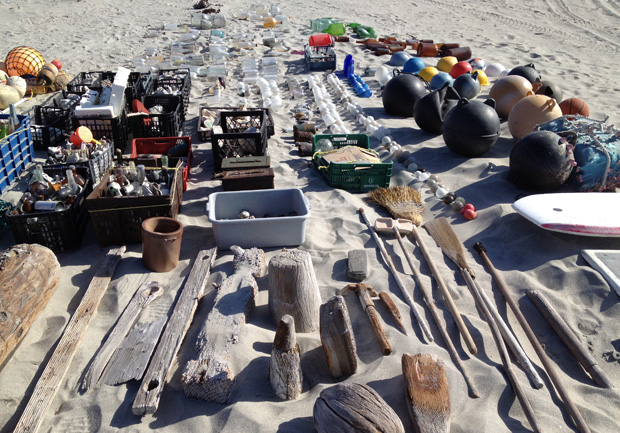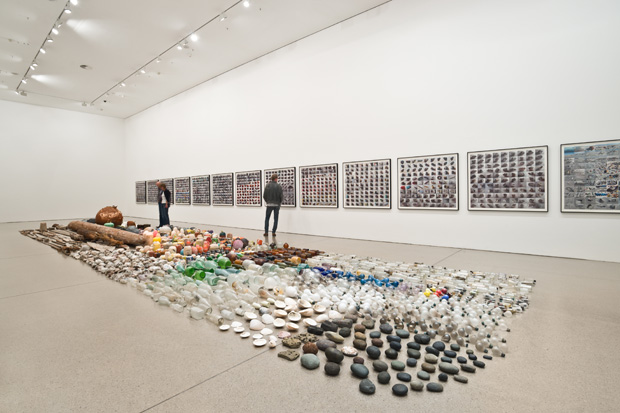 Currently in exhibition at the Deutsche Guggenheim in Berlin, Mexican artist Gabriel Orozco’s Asterisms features thousands of waste objects collected from two locations, a bay along the coast of Mexico and a playing field in New York City. Asterisms is a work that reflects on the culture of waste; where it comes from, where it ends and the processes it goes through in between. In my opinion, Orozco’s work seems to be a negotiation between a postmodern representation of the waste culture and a somewhat modernist construction of ideals concerning this culture. As I will argue in this article, Orozco has succesfully combined postmodern deconstructionism with what you could call a (meta)modern (re)construction.
Currently in exhibition at the Deutsche Guggenheim in Berlin, Mexican artist Gabriel Orozco’s Asterisms features thousands of waste objects collected from two locations, a bay along the coast of Mexico and a playing field in New York City. Asterisms is a work that reflects on the culture of waste; where it comes from, where it ends and the processes it goes through in between. In my opinion, Orozco’s work seems to be a negotiation between a postmodern representation of the waste culture and a somewhat modernist construction of ideals concerning this culture. As I will argue in this article, Orozco has succesfully combined postmodern deconstructionism with what you could call a (meta)modern (re)construction.
Orozco’s Asterisms consists of two projects presented in a large room where the windows have been blocked by flawlessly white walls. The first part of Asterisms is made up from debris and garbage collected at a playing field near Orozco’s home in New York, mostly consisting of small objects – i.e. pieces of gum, leftover paper, zippers, plastics and glass. The other part of Asterisms is composed of larger waste objects, collected from a bay along the western coast of Mexico – drift wood, toilet paper, buoys, spades, bottles, lamps and the like. These two collections of objects are presented centrally in the room. Around the actual objects are hundreds of studio photographs of the objects, all categorically ordered by size, color and type.
On the surface, Orozco’s collection of debris seems like a very postmodern approach to documenting the waste culture. Indeed, many aspects of his work can be linked to postmodern ways of representing culture. By highlighting small objects, both figurativaly as well as literally, Orozco draws the visitors’ attention away from centralized narratives and towards the periphery of the waste culture. Especially the fact that Asterisms features close-up studio photographs of every object seems to emphasize the postmodernist’s deconstructive approach to culture. In this manner, Orozco’s work draws its viewers away from the macro- into the micro-aspects of society.
Asterisms also places itself in a discours that questions the differences between ‘high’ and ‘low’ art. By taking a large collection of waste and debris and making it the central object of attention in a museum, Orozco seems to aim at deconstructing traditional museum practices. Where traditionally museums were meant as a metaphorical ‘food for thought’, and garbage as the excess and unwanted remnants of society, Asterisms seems to create a vicious cultural circle. The excess and unwanted products of society become the ‘food for thought’.
But there is more to Orozco’s work than postmodern techniques of representation. By placing every object carefully in a network of other objects, ordering them by color, type and size, Orozco seems to be trying to re-create a larger narrative concerning the waste culture. Each object has its own representation – especially in combination with its studio photograph. The problem with each of these objects though, is that they only consist of narratives that seem to exist separately from eachother. Peripheral narratives, if you will. By putting all these objects together inside a museum in a type of network or system, Orozco aims at re-constructing all these deconstructed narratives.
While all objects taken by themselves each represent a part of the waste culture, combined together through careful placement they can form a more coherent narrative. Orozco’s display of decay and erosion that is apparent in each object is, for example, constructed to a larger narrative by placing each object in relation to another. This creates a larger narrative of erosion constructed by combining each object’s ‘small narrative’.
This (re)construction of narrative is also apparent in the work’s title. Asterisms are groups of stars that are only linked together because we as humans often see them together. Stars in asterisms might lie very far apart, but because they are seen by the human eye looking at the night sky as close together, they form groups. Asterisms are created because humanity desires to classify the things we see in the sky. They are not necessarily related astronomically, but in a way, they reference to human’s desire for order in chaos. Orozco’s Asterisms is closely related to the idea that order, classification and understanding is necessary – even though this order is only logical taken from the subjective experience of the human eye. In this manner, Orozco seems to be saying that having a larger, more centralized narrative is necessary, even though we know that this narrative is subject to our own experience of the world.
Not only does Asterisms attempt at (re)constructing a larger narrative surrounding the waste culture, it also focusses on offering the viewer aesthetic pleasure. Instead of deconstructing a term such as aestheticism, the decaying objects present themselves in many colours and forms, evolving in size and shape as a type of wave. To me this means that Orozco aims at showing that erosion as a process can also be seen from an aesthetic viewpoint. Orozco does not necessarily focus on the (post)modern intellectual side of art, instead he emphasizes the viewers’ sensibility.
In this way, Asterisms can be seen as an oscillation between the postmodern micro – focussing on the details in the waste culture and peripheral narratives – and the modern macro – focussing on so-called centralized narratives. I believe this metamodern approach to the waste culture – constantly negotiating between the micro and the macro – is the leitmotiv in Gabriel Orozco’s Asterisms. By first deconstructing and then re-constructing, Orozco is able to carefully create a larger and more centralized narrative concerning the waste culture than by merely using a postmodern approach. In Asterisms, the metamodern approach can be seen as a useful tool in bringing together decentralized and deconstructed narratives of the waste culture, in order to carefully let the construction of a large narrative come into existence.

Images: Top: Sandstars, 2012 © Gabriel Orozco.
Bottom: Installation view © Gabriel Orozco. Photo by Mathias Schormann, courtesy Deutsche Guggenheim
